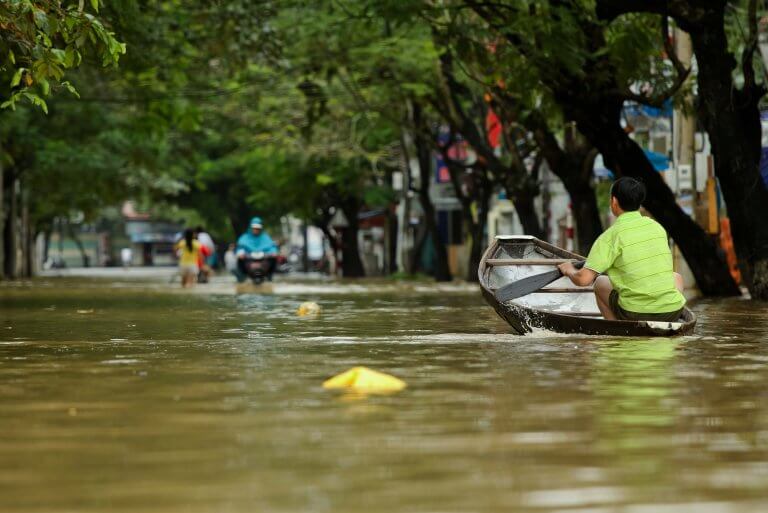Swiss Re: Natural catastrophes: Keeping an eye on the elephant in the room
April 15 2020
Russell Higginbotham, CEO Reinsurance Asia at Swiss Re shares his view.
Covid-19. Battling this virus has turned out to be unlike any other war we’ve fought. World leaders have drawn from wartime speeches of yesteryear to rally citizens. At home, families fear — and hide from — the unknown. And for many, it’s not a question of if, but when, they contract Covid-19.
As we continue battling the spread of this virus and take extraordinary measures the likes of which have never been seen, there are other events — not “ifs” but “when” — that require those of us in Asia to keep a watchful, wary eye on.
Every year, natural catastrophes claim thousands of lives, render millions homeless, and leave economies with significant recovery challenges. The latest World Economic Forum report ranks climate change as the biggest global threat to us for the next decade.
Right now, are we ready for the next big typhoon or earthquake? Can we deal with the monsoon season at the same time as we’re fighting COVID-19?
Climate change is complicating the global risk landscape. The effects of global warming are evident in many ways,  and extreme weather more frequent and severe.
and extreme weather more frequent and severe.
We’ve heard it before. Higher average temperatures, longer and more frequent heatwaves, rising sea levels, a major cause of extreme flooding, and more severe rainfall are wreaking havoc across the globe. Climate change is also influencing secondary perils so much so that they can scant be considered “secondary” any longer. Elsewhere, higher average temperatures and unprecedented dryness made this past Australian bushfire season the most extreme on record, according to Swiss Re Institute’s sigma publication.
Our research tells us there were 317 disaster events in 2019. Of these, 107, or a third, happened in the Asia-Pacific region. The Australian bushfires, flash floods across South-East Asia, and Typhoon Lekima in China were front and centre in our living rooms and on our news feeds. Still, they didn’t cause the most damage. When they made landfall in densely populated Japan, Typhoons Hagibis and Faxai left a destructive trail in their wake and resulted in at least US$15 billion in insured losses, according to Swiss Re figures.
Beginning in September 2019 and lasting half a year, the recent Australian bushfire season scorched 16 million hectares of area and resulted in US$1.5 billion insured losses so far, according to the Insurance Council of Australia. The images of scorched agricultural and pastoral land, dead and dying animals, and of angry and distraught landowners will long live in memory.
What we need to avoid is to think that these were once-in-a-generation events, science tells us that they will happen again… and more frequently.
These are just the insured losses. For every insured dollar lost, there is at least another US$2 that is not covered by insurance. Of the US$70 billion in economic losses last year, only US$20.8 billion was insured, meaning about US$50 billion that could have gone to improved infrastructure and getting people and businesses back on their feet quickly was lost because governments or individuals willingly chose to bypass an insurance solution.
Insuring our future
Unless there is a significant change in how insurance is viewed as a risk transfer mechanism, the protection gap will continue to widen. Asia’s growth, industrialisation and urban migration patterns will see to that.
To keep up with the dynamic climate risks, some of the things insurers can do are to continuously reassess our underwriting processes, incorporate latest scientific findings and strengthen our capacity to deal with natural catastrophes. Working with insurers, end clients and third parties we need to find ways to increase societies’ resilience to natural catastrophes. This in turn increases the availability of insurance cover and helps to reduce the cost. Bearing this mitigation in mind, to close the protection gap, we need to keep reminding everyone that insurance is really one of the most reliable, affordable and efficient ways to protect yourself against the risks of climate change.
But we also need to innovate. We need to make our products easier to understand and access. We know that a parametric solution — claims that are triggered on pre-agreed conditions — is one way to get more people insured against climate risk and nat cats. Everyone needs a quick and painless solution to claim especially when getting back to normality quickly is so very important.
One example is our joint venture with Groupama AVIC, where we helped create a parametric product to protect citizens in China’s Mao County against floods, earthquakes, landslides, heavy rainfall, among others. This product’s rapid payout helps with fast relief and reconstruction efforts in one of the most earthquake-prone regions in the world.
In Japan, we worked with Zurich Insurance to design a parametric solution that anyone can buy off the shelf via their credit card, bank, or even their utility company. In a country where earthquakes are detected every five minutes, easy access — and payouts — can benefit millions of people.
The longer we leave climate change unmitigated, natural catastrophes will reach an irreversible tipping point where insurance cover will become unaffordable to many or even worse, no longer available. We can’t allow that to happen.
To close the protection gap and build resilience at scale and speed, public-private partnerships have an important role to play. While convincing individuals to purchase protection remains challenging, public sectors don’t have to shoulder the burden alone. Swiss Re supported the issuance of catastrophe-linked bonds in the Philippines, one of the world’s most disaster-prone economies. A cat bond is triggered if certain conditions are met, and the principal is paid out very quickly in order for the government to ease the societal burden from a disaster event. In a country where a fifth of the population live below the poverty line, this is more of a necessity than a desire.
Covid-19 has made it an even more challenging year — one that puts everyone’s resilience under greater strain. According to the UN Trade and Development Agency, this outbreak could cost the global economy as much as US$2 trillion. What happens if there is a major earthquake, typhoon, flood or fire in your country at the same time we’re still dealing with Covid-19?
We knew even before 2020 began that we would have to contend with climate risk and its knock-on effects on natural disasters. To deal with two major unknowns like Covid-19 and nat cats would be a very challenging situation for those impacted. Maybe this was the wake-up call we needed. Maybe seeing rivers run clear, animals coming into urban settings and smog-free skies will be something that inspires more of us. There is never a better time than the present to deal with it.

Russell Higginbotham
CEO Reinsurance Asia
Swiss Re
General enquiry:
[email protected]
-
Allianz General | Allianz General combines innovative protection solutions while powering social good to lead Malaysian market
The carrier proactively addresses emerging risks and evolving customer protection needs while giving back to the community.
-
Sedgwick | Asia’s Energy Transformation – Balancing Growth, Risk and Renewables
Energy market presents unique risks, especially in a region which includes China and Japan as well as developing nations like Vietnam and the Philippines.
-
Beazley | Turbulent Waters: the maritime energy transition challenge
Businesses are facing a complex transition to non-carbon energy sources amid a push to achieve net-zero emissions for the marine sector by 2050.
-
Aon | Navigating shifts in the global and Asia insurance markets
Neelay Patel, Aon head of growth for Asia, says the market in Asia is at an ‘interesting stage of the cycle’.
